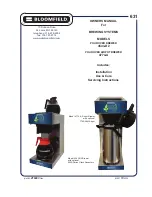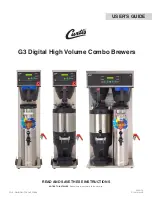
22
EN
22
EN
1. General safety instructions
GENERAL
Machine design and construction allows for safe use and
maintenance. This is true provided that the installation is done
as described in this guide. The guide should be read and the in-
structions followed by anyone working with the machinery. It is
the customer’s responsibility to ensure that the instructions are
complied with by staff.
In some countries or some companies more safety regulations are
to be observed, mainly related to personnel. This documentation
does not take account of such company-speci c or national
guidelines. The technical speci cations in the manual shall be
suf cient to base for decisions on any local safety regulations.
Consult with the appropriate the authorities or with company
safety representatives.
This documentation distinguishes between ”normal operation”
(see Chapter 3-4 Running the machine) and ”other management”
(see Chapter 5 Care and daily maintenance). The reason is that
they place different demands on operators and service personnel,
specially in regards to security.
Easier maintenance, as described in Chapter 4, may also be
performed by operators. Maintenance only described in Chapter 5,
only carried out by skilled service personnel.
SAFETY
Here are the rules to be observed: Ensure that no children or
animals in the vicinity of the installation.
Only people who have read and understand this manual may work
with this machinery. Do not tamper with the machine while it is
working or is on. Warning! Even if the machine is not working,
it may be switched on. Safety devices shall not be removed or
eliminated. All the protection of electrical and mechanical compo
nents must be correctly installed when the installation is in
operation. The safety devices are essential for safety in the work
environment. Thus, it is strictly forbidden in any way ignore or
circumvent them. Keep the work area clean and free of foreign
objects. Make sure the lighting in the work area is adequate.
UNAUTHORIZED USE
Some use may lead to unnecessary security risks because they are
not in conformity with the machine’s speci cations and therefore
unlawful. You may not:
•
wrap pallets that do not meet speci cations
•
wrap pallet goods exceeding the maximum allowable weight
•
wrap pallet goods which have not been stacked properly.
Keep in mind that even if the goods look like it is stacked
properly, packages can still fall due to other causes
•
wrap pallets that are in poor condition
•
wrap pallets that extends outside the periphery of the turn
table
•
negligering of installation speci cations
•
wrap unpackaged foods
USERS
Operators
The machine may be operated by any adult person who has read
and understood the contents of Chapters 1-4. It is not necessary
that the operators have any special knowledge. Machine operators
are trained by personnel from Cyklop or by Cyklop designated
dealers.
The operator is normally involved in the following tasks:
•
operation of the machine
•
daily standard maintenance This means for example cleaning
of photocells - no major tasks may be performed.
•
ensure that dangerous situations can not arise.
•
keep the work area clean and free from foreign objects.
Service
Speci c skills, experience and / or training is required. Service
personnel should also master the entire contents of this
documentation. Service typically have the following types of tasks:
•
maintenance of the installation
•
repair of defects
•
give support to operators
Service personnel shall after rectifying an error restore the
machine to original state. With security in mind, this means for
example, re-installation of protective caps and also return safety
switch to its original position. When a service person take their
own initiatives to implement changes in the installation, the
customer forfeits the moment of their warranty claims in the case
of any problems as a consequence of the change.
PERSONAL PROTECTION
Some personal protection measures are not to be taken by
operators of the machine. However, a number of measures
are recommended. For example shoes with steel caps, hearing
protection, etc.. Some products used, however, may require
protective measures - advice the documentation of those devices.
When handling sheet metal take certain precautions to prevent
injuries such as hand injuries and the likes. When performing
service local safety regulations must be folowed. Discuss personal
safety with company safety representatives.
The whole installation was designed and tested to work with the
speci ed substances. Unforeseen dangers may arise from the use
of substances other than those speci ed. The manufacturer can
not accept responsibility for the complications arising from the use
of substances other than those speci ed.
TRANSPORTATION
When transporting the installation on a public road, there may
be local regulations to follow. Consult with national and local
authorities on these kinds of regulations and if application for a
permit is needed.
ENVIRONMENTAL CONCERNS
Potential environmental risks are in the form of, for example, oil,
grease and detergent. This type of substances are to be disposed
of in accordance with national environmental regulations.
DISPOSAL OF THE MACHINE / INSTALLATION
If and when the machine is disposed local environmental
regulations must be observed. The machine contains only material
that can be considered public knowledge. All the materials in the
machine was at the time of manufacture of such a nature that
they could be disposed of in an environmentally sound manner
and without risk of personal injury.
DISASTERS
Disasters include re, ood, and the like. There are no speci c
rules for the conduct of disaster relief.
Fire ghting can be done under the usual standards.
















































